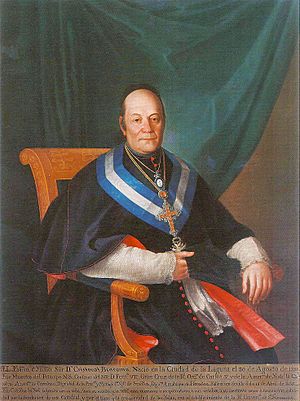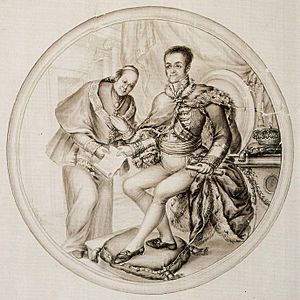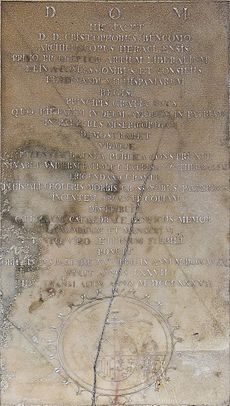Cristóbal Bencomo y Rodríguez facts for kids
Quick facts for kids Cristóbal Bencomo y Rodríguez |
|
|---|---|
| Titular Archbishop | |

Portrait of Cristóbal Bencomo y Rodríguez in La Laguna Cathedral (Tenerife)
|
|
| See | Titular Archbishop of Heraclea |
| Personal details | |
| Born | 30 August 1758 San Cristóbal de La Laguna, Spain |
| Died | 15 April 1835 Sevilla, Spain |
| Nationality | Spaniard |
| Denomination | Catholic |
| Profession | Confessor of King Ferdinand VII of Spain |
Cristóbal Bencomo y Rodríguez (born August 30, 1758, in San Cristóbal de La Laguna, Tenerife, Spain – died April 15, 1835, in Sevilla, Spain) was an important Catholic priest from Spain. He was known for being the personal confessor, or spiritual advisor, to King Ferdinand VII of Spain.
Bencomo played a big part in creating the University of La Laguna. This was the first university in the Canary Islands. He also helped establish the Diocese of San Cristóbal de La Laguna. This new church area separated the western Canary Islands into their own bishopric. He held many important titles and was a key figure in the Spanish Catholic Church.
Contents
Biography
Early Life and Education
Cristóbal Bencomo was born in San Cristóbal de La Laguna on the island of Tenerife. His parents were Francisco Braulio Bencomo and Bárbara Rodríguez Fleitas. He was born on August 30, 1758.
Cristóbal had two brothers, Pedro José and Santiago. All three brothers became important church leaders. They helped a lot with founding the University of San Fernando, which is now the University of La Laguna. They also supported the building of the Cathedral of La Laguna. Most importantly, they worked together to create the Diocese of San Cristóbal de La Laguna. The three brothers were descendants of Kebehi Benchomo, who was the last Guanche mencey (an aboriginal king) of Taoro. Cristóbal Bencomo was the most important of the three in setting up the university and the new church area.
Cristóbal started his studies with Franciscan friars. He was very good at studying philosophy and theology. He also learned a lot about the Latin language and its literature. In 1790, he became a preacher and was appointed master of pages. After this, he moved to Madrid to find more opportunities. There, he studied Greek literature and the Greek language.
Confessor to the King
In 1793, King Carlos IV of Spain made Cristóbal Bencomo a philosophy teacher for his young knights. Later, he became a Latin professor for the Prince of Asturias. This prince would later become King Ferdinand VII of Spain. In 1800, Bencomo became Prince Ferdinand's confessor. They developed a close relationship.
When King Carlos IV and Prince Ferdinand VII went to meet Napoleon in Bayonne, Bencomo returned to Tenerife. He stayed there until 1814. When Ferdinand VII returned to Madrid as King, he asked Bencomo to come back to court. The King even sent a warship just to bring Bencomo back with great honor.
In 1815, King Ferdinand VII gave Cristóbal Bencomo important titles. He became a board member and chamber member of Castilla. He also received the Grand Cross of the Royal and Distinguished Order of Carlos III. The King himself gave him this award in 1817. In the same year, Pope Pius VII gave Bencomo the title of Titular Archbishop of Heraclea. This was a special honor given by the Pope.
Creating the University and Diocese
Cristóbal Bencomo y Rodríguez was key in starting the first university in the Canary Islands. It was called the Literary University of San Fernando in San Cristóbal de La Laguna. This university, now known as the University of La Laguna, was officially created by the King in 1816.
He also strongly supported and helped create the Diocese of San Cristóbal de La Laguna. In 1818, he worked with the church and leaders in Tenerife. They asked the Holy See (the Pope and his advisors) to create a new church area for the Canary Islands. King Ferdinand VII fully supported this request. On February 1, 1819, the Pope approved dividing the old Canary Islands bishopric into two dioceses. This new diocese was officially created between February and December 1819. Before this, one bishopric managed the entire archipelago. The Diocese of San Cristóbal de La Laguna now includes the islands of Tenerife, La Palma, La Gomera, and El Hierro.
Creating this new diocese was very important historically. People on Tenerife had tried to get their own diocese since the early 1500s. This was right after the conquest of the Canary Islands by the Crown of Castile. However, the bishop on Gran Canaria and other church leaders always opposed it. For three centuries, requests from Tenerife were denied. But with Cristóbal Bencomo's cleverness and King Ferdinand VII's strong support, the diocese was created quickly and easily. This shows Bencomo's important connection to this church project.
Later Life and Death
In 1818, King Ferdinand VII offered Bencomo the position of Inquisitor General of Spain. This was a very powerful role in the Spanish Inquisition. However, Bencomo turned down this offer. He believed the Inquisition was an old institution that would soon disappear. He felt it was not popular with most people, both religious and non-religious. After this, his influence with the King and at the Spanish Court began to lessen.
As he got older and became sick, Bencomo moved to Seville. The King gave him permission to go. In Seville, he held the title of Archdeacon of Carmona. He helped people in Seville during big problems, like a cholera outbreak in 1823. To show their thanks, the people of Seville placed his portrait in the library of the Cathedral of Seville.
Cristóbal Bencomo and his brothers helped pay for the new front of the Cathedral of San Cristóbal de La Laguna. Cristóbal also gave his personal library to the new bishopric he helped create. He also donated two important relics to the cathedral. These were a piece of the cloak of Saint Ferdinand III of Castile and a bone of St. James the Less.
Cristóbal Bencomo y Rodríguez died in Seville on April 15, 1835. He was first buried in the Cathedral of Seville. In 1837, his remains were moved to the Cathedral of La Laguna in his home island of Tenerife.
Bencomo's Brothers
Cristóbal Bencomo's two brothers were also very influential church leaders in the Canary Islands.
His brother Pedro José (1749-1828) was a canon (a type of priest) at the Las Palmas Cathedral in Las Palmas de Gran Canaria. Later, he became the first dean (a senior priest) of Tenerife after the new diocese was created. Pedro José also helped set up the University of San Fernando and was its first leader.
His brother Santiago (1754-1818) was also a dean and canon at the Cathedral of Santa Ana de Las Palmas. He had special titles, including a knight of the Order of Carlos III. He was also chosen to be a bishop for Astorga and had a doctorate in sacred theology. A story about Santiago tells how in 1810, when a yellow fever epidemic hit the islands, many leaders fled Las Palmas. But Santiago stayed at his post, helping those who were sick.
Legacy
Cristóbal Bencomo y Rodríguez was the person who made it possible to establish the first university in the Canary Islands. This university was in his hometown of San Cristóbal de La Laguna. This made his city as important as other big cities in Spain that had famous universities, like the University of Salamanca.
By helping create the new diocese, he also brought church independence to Tenerife and the western Canary Islands. Before this, all the islands were under one bishopric based in Las Palmas. Most people on Tenerife and the western islands saw this as a very good change.
However, the creation of the bishopric also caused some disagreements. Some people believe it started the "Pleito insular" (island dispute). This was a long-standing rivalry between the wealthy people of Tenerife and Gran Canaria. They argued over who had more power in the Canary Islands. Others think this rivalry started much earlier.
Works
Cristóbal Bencomo was also a writer. He wrote several books and letters:
- Instituciones Filosóficas para la enseñanza del Príncipe (Philosophical Institutions for the Teaching of the Prince)
- Carta a una señorita que le participó su estado de matrimonio (Letter to a young lady who shared her marriage status) (1804)
- Informe presentado a S.M. sobre el establecimiento de la Universidad en Canarias (Report presented to His Majesty on the establishment of the University in the Canaries) (1816)
He also translated parts of the New Testament from Greek. He translated Sueño de Luciano (Lucian's Dream) and Tabla de Cebes (Table of Cebes).
See also
 In Spanish: Cristóbal Bencomo y Rodríguez para niños
In Spanish: Cristóbal Bencomo y Rodríguez para niños



